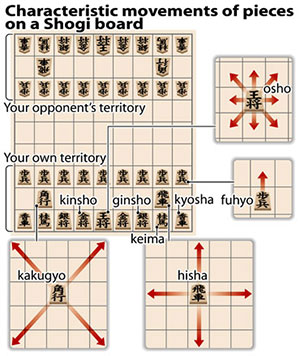
Children competing and enjoying a game in a Shogi class in Tokyo. (Courtesy of Japan Shogi Association)
Shogi, also known as Japanese chess, is a boad game familiar to many people in Japan from years back. It is a game similar to chess where 2 people confront each other, divided into allies and foes, and compete for victory, or defeat, by moving koma (pieces) labeled with letters on a square Shogi board that is divided horizontally and vertically into 81 squares. The prevailing theory is that the original game was created in ancient India. It was passed to Japan around the 6th century, and took on the form of a unique Japanese game around the 15th or 16th century.
The Osho is King
The game begins with the opponents lining up their 20 pieces in their own territory; these pieces are of 8 different varieties, including the Osho (king general). Players take turns competing for their opponent's pieces by moving their own "friendly" pieces; the first to take their opponent’s Osho is the winner. The way of advancing in the basic game is the same as chess that was created in Europe.

For example the most important piece is the Osho, like the King in chess, and if your opponent takes your Osho, you are beaten. The two pieces not only have the same role in this respect, they can also be moved just like each other, one square at a time in any of 8 directions, vertically, horizontally or diagonally. In addition there are other pieces that move in exactly the same ways: the fuhyo (soldier) and the pawn both move straight ahead, one square at a time; the hisha (rook) and the rook can move any number of squares vertically or horizontally; while the kakugyo (bishop) and the bishop can move anywhere on the diagonal.
However in Shogi, 6 categories of piece change the way they move once they enter the opponent's territory and become 'stronger' pieces; whereas in chess only pawns have this same "ability." In addition, a specific rule that only applies to Shogi is that you can use pieces that you have captured from your opponent as "friendly" pieces.
It Teaches Manners

Elementary school pupils learning strategic moves in a Shogi class. (Courtesy of Japan Shogi Association)
In Shogi, once the game has concluded both sides recognize each other's good fight; the side that lost shouts out "That's me beaten" and takes a bow, while the side that won also bows. Even if you win, it is good manners to not look too happy, or adopt a winning pose. At the start of a match players also greet each other by saying “o-negai shimasu” (please grant me your favor) and just like the tradition-steeped martial arts, Shogi also teaches us basic manners for social living.
It is also said that learning Shogi naturally teaches you the ability to judge the status of your own position and that of your opponent; the ability to make decisions in times of doubt; and the endurance to never give up on the game. Consequently, while Shogi has long-since been considered a game for adults, it has recently been reconsidered as a method of training children to stretch their abilities and talents. And in much the same sense as those studying in cram-schools, the number of children attending Shogi classes is also on the increase.

“Animal Shogi” – you can play a game using a total of 8 pieces on a 12 squared board. The rules are that if you can catch the lion, or if your lion enters your opponent's territory, you win. © Madoka Kitao,Maiko Fujita
In addition, "Animal Shogi" has been developed for preschoolers to become familiar with the fun of Shogii; on this board there are only 12 squares and a total of 8 pieces, which the children enjoy moving around. Each piece is drawn with pretty pictures of lions or chicks etc., and if you try it, you will see that it is packed full of the fun of Shogi - so much so that it can even be enjoyed by adults.

Surrounded by Shogi boards - children hone their skills and train their minds, competing in serious matches.(Courtesy of Japan Shogi Association)